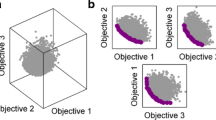Abstract
Visual representation of a many-objective Pareto-optimal front in a high-dimensional (four or more) objective space requires a large number of data points. Choosing a single point from a large number of data points even with preference information is problematic, as it causes a large cognitive burden on the part of the decision-makers. Therefore, many-objective optimization and analytics practitioners have been interested in practical visualization methods that enable them to filter down a large set of data points to a few critical points for further analysis. Most existing visualization methods are borrowed from other data analytics domain and they are too generic to be effective for many-criteria decision making. In this paper, we propose a visualization method, following an earlier concept, using star-coordinate plots for effectively visualizing many-objective trade-off solutions (data points). We demonstrate the use of the proposed method to a couple of high-dimensional test problems and a 4-objective portfolio optimization problem. We also show a case of interactive exploratory data analytics where we use the ‘Pareto Race’ technique from the multi-criteria decision analysis (MCDA) literature to demonstrate the ease and advantage of the proposed visualization method.









Similar content being viewed by others
Notes
In this paper, we denote each data point with \(\mathbf {f}\) instead of a more standard notation \(\mathbf {x}\). Since each data point \(\mathbf {f} = (f_1, f_2, \ldots , f_m)\) is a vector of objective function values in \({\mathbb {R}}^{m}\).
Or \(\mathcal {D} \subset {\mathbb {R}}^{3}\) for the case of three-dimensional visualization.
This might depend on the properties of the data set as well
In our case the total number of stock is 12, i.e. \(n = 12\).
Or, we can restart the entire procedure to explore other points in the vicinity of \(F_4\).
References
Barber CB, Dobkin DP, Dobkin DP, Huhdanpaa H (1996) The Quickhull algorithm for convex hulls. ACM Trans Math Softw 22(4):469–483. https://doi.org/10.1145/235815.235821
Branke J, Deb K, Dierolf H, Osswald M (2004) Finding knees in multi-objective optimization. In: Yao X et al (eds) Parallel problem solving from nature—PPSN VIII. Springer, Berlin Heidelberg, pp 722–731
Chiam SC, Tan KC, Al Mamum A (2008) Evolutionary multi-objective portfolio optimization in practical context. Int J Autom Comput 5(1):67–80. https://doi.org/10.1007/s11633-008-0067-2
Deb K, Jain H (2014) An evolutionary many-objective optimization algorithm using reference-point-based nondominated sorting approach, part i: solving problems with box constraints. IEEE Trans Evol Comput 18(4):577–601. https://doi.org/10.1109/TEVC.2013.2281535
Deb K, Thiele L, Laumanns M, Zitzler E (2002) Scalable multi-objective optimization test problems. In: Proceedings of the 2002 Congress on Evolutionary Computation. CEC’02, pp. 825–830. https://doi.org/10.1109/CEC.2002.1007032
Edelsbrunner H, Kirkpatrick D, Seidel R (1983) On the shape of a set of points in the plane. IEEE Trans Inform Theory 29(4):551–559. https://doi.org/10.1109/TIT.1983.1056714
Filipič B, Tušar T (2018) A Taxonomy of Methods for Visualizing Pareto Front Approximations. In: Proceedings of the Genetic and Evol Comput Conf, pp. 649–656. ACM, New York, NY. https://doi.org/10.1145/3205455.3205607
He Z, Yen GG (2016) Visualization and performance metric in many-objective optimization. IEEE Trans Evol Comput 20(3):386–402. https://doi.org/10.1109/TEVC.2015.2472283
Kandogan E (2001) Visualizing multi-dimensional clusters, trends, and outliers using star coordinates. In: Proceedings of the Seventh ACM SIGKDD International Conference on Knowledge Discovery and Data Mining, pp. 107–116. ACM, New York, NY. https://doi.org/10.1145/502512.502530
Korhonen P, Wallenius J (1988) A Pareto race. Naval Res Logist (NRL) 35(6):615–623https://doi.org/10.1002/1520-6750(198812)35:6h615::AID-NAV3220350608i3.0.CO;2-K
Levy A (2017) The circumradius of a simplex via edge lengths. Independent Technical Report
Liu RY (1990) On a notion of data depth based on random simplices. Ann Stat 18(1):405–414
van der Maaten L, Hinton G (2008) Visualizing data using t-SNE. J Mach Learn Res 9(Nov):2579–2605
Munkres J (1996) Elements of algebraic topology. Avalon Publishing
Rachmawati L, Srinivasan D (2009) Multiobjective evolutionary algorithm with controllable focus on the knees of the pareto front. IEEE Trans Evol Comput 13(4):810–824. https://doi.org/10.1109/TEVC.2009.2017515
Rubio-Sánchez M, Raya L, Díaz F, Sanchez A (2016) A comparative study between RadViz and Star Coordinates. IEEE Trans Vis Comput Graph 22(1):619–628. https://doi.org/10.1109/TVCG.2015.2467324
Sarykalin S, Serraino G, Uryasev S (2008) Value-at-Risk vs. conditional value-at-risk in risk management and optimization, chapter 13, pp 270–294. Informs. https://doi.org/10.1287/educ.1080.0052
Singh G, Mémoli F, Carlsson GE (2007) Topological methods for the analysis of high dimensional data sets and 3D object recognition. SPBG. https://doi.org/10.2312/SPBG/SPBG07/091-100
Talukder AKA, Deb K (2020) Paletteviz: a visualization method for functional understanding of high-dimensional Pareto-optimal data-sets to aid multi-criteria decision making. IEEE Comput Intell Mag 15(2):36–48
Tan SC, Tan J (2017) Lost in translation: The fundamental flaws in star coordinate visualizations. Procedia Comput Sci 108:2308–2312. https://doi.org/10.1016/j.procs.2017.05.087
Tušar T, Filipič B (2015) Visualization of pareto front approximations in evolutionary multiobjective optimization: a critical review and the prosection method. IEEE Trans Evol Comput 19(2):225–245. https://doi.org/10.1109/TEVC.2014.2313407
Wierzbicki AP (1980) The Use of reference objectives in multiobjective optimization. In: Fandel G, Gal T (eds) Multiple criteria decision making theory and application. Springer, Berlin Heidelberg, pp 468–486
Wilkinson L, Friendly M (2009) The History of the cluster heat map. Am Stat 63(2):179–184. https://doi.org/10.1198/tas.2009.0033
Author information
Authors and Affiliations
Corresponding author
Rights and permissions
About this article
Cite this article
Talukder, A., Deb, K. An improved visual analytics framework for high-dimensional pareto-optimal front: a case for multi-objective portfolio optimization. J BANK FINANC TECHNOL 5, 105–115 (2021). https://doi.org/10.1007/s42786-021-00031-8
Received:
Accepted:
Published:
Issue Date:
DOI: https://doi.org/10.1007/s42786-021-00031-8




